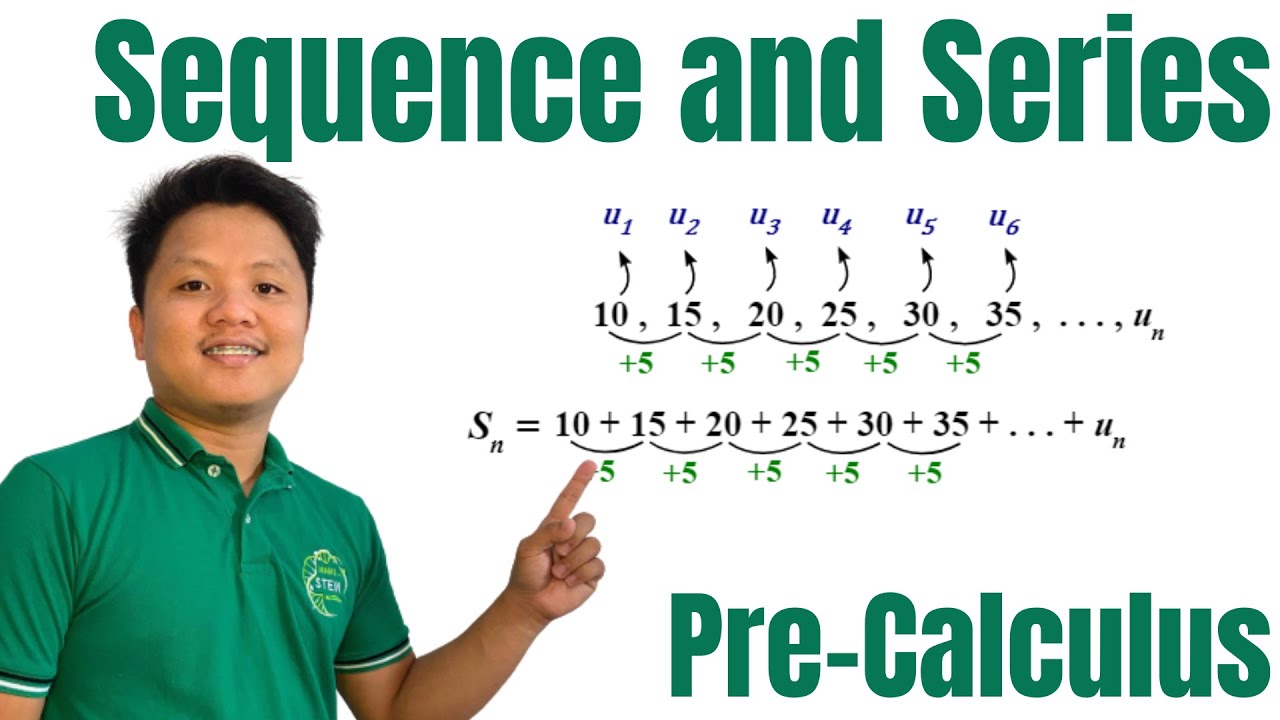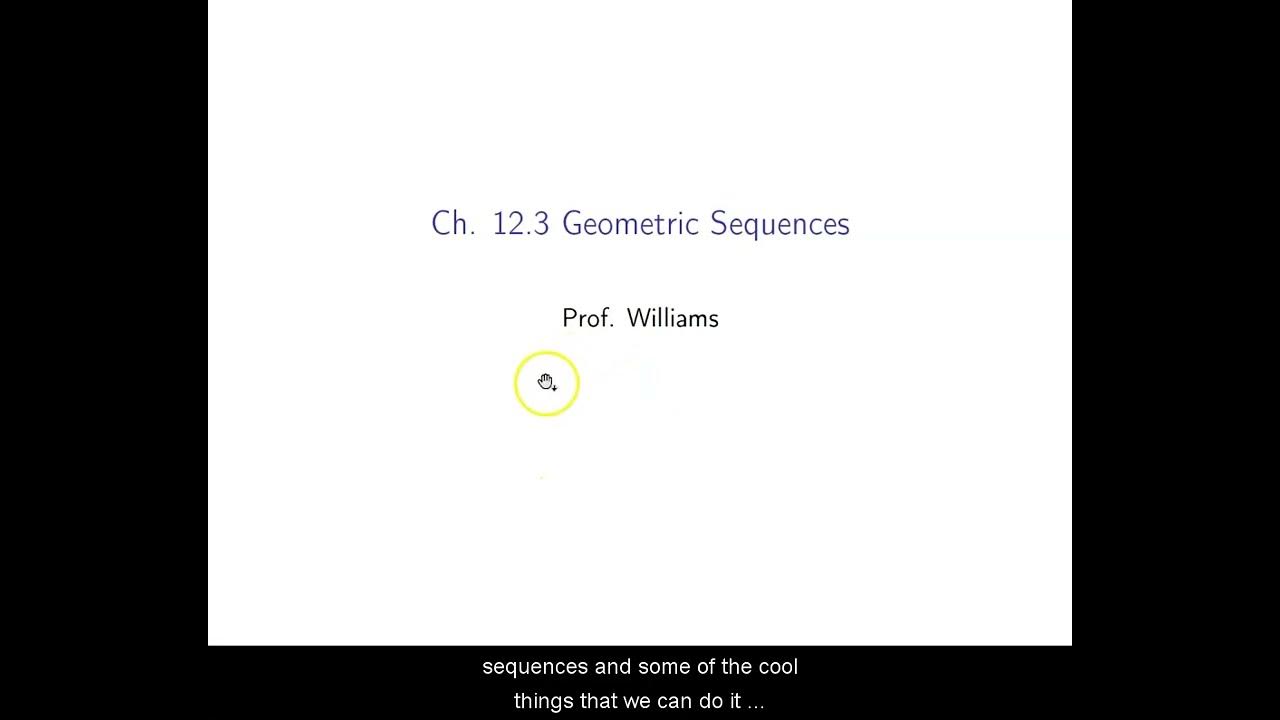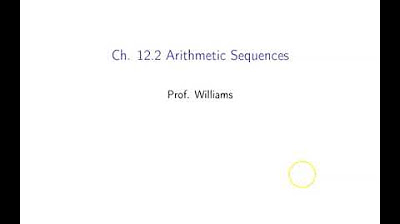Arithmetic Sequences (Precalculus - College Algebra 69)
TLDRThe video script provides an in-depth exploration of arithmetic sequences and series, a fundamental concept in mathematics. It explains that an arithmetic sequence is a sequence where the difference between any two consecutive terms is constant, which is referred to as the common difference. The script illustrates how to identify the first term and common difference of a sequence and how to use these to find any term in the sequence, including the 100th term, through a formulaic approach. It also touches on the concept of recursive definitions and how they differ from arithmetic sequences. The video further demonstrates how to solve for the first term and common difference when only a couple of terms from the sequence are given, using a system of equations. The script emphasizes the importance of recognizing and classifying sequences and series, which is crucial for more advanced mathematical topics like calculus. The summary serves as a prelude to upcoming discussions on arithmetic series and the transition to geometric sequences and series.
Takeaways
- 📐 An arithmetic sequence is a sequence where the difference between any two consecutive terms is constant, meaning the same number is added repeatedly to generate each term.
- 🔢 The formula for the nth term of an arithmetic sequence is given by a_n = a_1 + (n - 1)d, where a_1 is the first term and d is the common difference.
- 🔍 The term 'common difference' refers to the constant number added between each pair of consecutive terms in the sequence.
- 🚀 To find a specific term in an arithmetic sequence, you do not need to add the common difference to every term before it; instead, use the formula which accounts for the number of terms from the first to the desired term.
- 🌐 The arithmetic sequence can be identified by taking any two terms and checking if their difference is the same as that of any other pair of consecutive terms.
- 📉 Arithmetic sequences can decrease if the common difference is negative, meaning that a negative number is added to each term to generate the next term.
- 🔁 Recursive definitions of sequences are based on the previous term(s), and while they can define a sequence, they may not be as efficient for finding far-reaching terms as explicit formulas.
- 🧩 If given two terms of an arithmetic sequence, you can set up a system of equations to solve for the first term and the common difference, which then allows you to define the entire sequence.
- 🧮 Solving systems of equations is a powerful tool for finding the underlying pattern or formula of a sequence when only a few terms are known.
- 📌 It's important to recognize the difference between a sequence and a series; a series involves the sum of the terms of a sequence, which is a distinct concept not covered in this script.
- ✅ Once the first term and common difference are identified, you can easily calculate any term in the arithmetic sequence without having to generate all preceding terms.
Q & A
What is an arithmetic sequence?
-An arithmetic sequence is a sequence of numbers in which the difference between any two sequential terms is constant. This constant difference is known as the common difference.
How do you identify the common difference in an arithmetic sequence?
-To identify the common difference, subtract any term in the sequence from the term that follows it. If the result is the same for any pair of consecutive terms, that result is the common difference.
What is the general formula for finding the nth term of an arithmetic sequence?
-The general formula for finding the nth term of an arithmetic sequence is a_n = a_1 + (n - 1)d, where a_1 is the first term and d is the common difference.
How can you use the arithmetic sequence formula to find a specific term, such as the 100th term?
-To find a specific term, such as the 100th term, you would substitute n with 100 in the formula a_n = a_1 + (n - 1)d and calculate the result.
What is the difference between an arithmetic sequence and an arithmetic series?
-An arithmetic sequence is a list of numbers where each term is found by adding a constant difference to the previous term. An arithmetic series, on the other hand, is the sum of the terms of an arithmetic sequence.
How is the common difference related to the slope of a linear function?
-The common difference in an arithmetic sequence is analogous to the slope of a linear function. It represents the constant rate of increase or decrease between consecutive terms in the sequence.
What is the recursive definition of an arithmetic sequence?
-The recursive definition of an arithmetic sequence is a way to express each term based on the previous term, typically in the form a_n = a_{n-1} + d, where d is the common difference.
How can you determine the formula of an arithmetic sequence if you are given two terms?
-If you are given two terms of an arithmetic sequence, you can set up a system of equations using the formula a_n = a_1 + (n - 1)d for each term. Solving this system will give you the values of the first term a_1 and the common difference d.
What is the significance of being able to classify sequences and series in higher mathematics?
-Classifying sequences and series is important in higher mathematics, such as calculus, because it allows for the application of specific formulas and tests to determine properties like convergence or divergence, which are crucial for understanding the behavior of the sequence or series.
How does the arithmetic sequence formula simplify the process of finding any term in a sequence?
-The arithmetic sequence formula simplifies the process by providing a direct calculation method for any term without the need to add the common difference repeatedly. It allows you to find any term by simply plugging in the term number and using the formula a_n = a_1 + (n - 1)d.
Can an arithmetic sequence have a negative common difference?
-Yes, an arithmetic sequence can have a negative common difference. This would result in a decreasing sequence, where each term is found by subtracting the common difference from the previous term.
Outlines
📚 Introduction to Arithmetic Sequences
This paragraph introduces the concept of arithmetic sequences, which are sequences where the difference between any two sequential terms is constant. The video explains that this constant difference is known as the common difference and provides a clear example to illustrate the concept. The speaker emphasizes the importance of identifying the starting term and the common difference in order to predict and calculate any term within the sequence. The formula for finding the nth term of an arithmetic sequence is introduced as a sub n = a sub 1 + (n - 1) times d, where a sub 1 is the first term and d is the common difference.
🔢 Understanding the Structure of Arithmetic Sequences
The second paragraph delves deeper into the structure of arithmetic sequences, explaining how to find specific terms within the sequence. It clarifies that the first term is considered as one of the terms, which affects the calculation of subsequent terms. The speaker uses the formula derived in the previous paragraph to demonstrate how to find the third term and the hundredth term of the sequence. The paragraph also distinguishes between sequences and series, noting that while the video is about sequences, series involve the summation of terms.
🧠 Recursive Formulas and Classification
This paragraph discusses the concept of recursive formulas, which define a sequence based on the previous term. The speaker explains how to find subsequent terms by adding a constant to the previous term. The paragraph also touches on the importance of classifying sequences, especially in higher-level mathematics like calculus, to determine properties such as convergence or divergence. An example of an odd number sequence is used to illustrate how identifying the type of sequence can simplify problem-solving.
📝 Solving for Unknowns in Arithmetic Sequences
The fourth paragraph focuses on solving for unknowns in arithmetic sequences when given specific terms. The speaker outlines a method for creating a system of equations based on two known terms and using these to find the first term and the common difference. A step-by-step process is provided, including setting up the equations, simplifying, and solving for the unknowns. The practical application of this method is demonstrated with an example where the eighth and twentieth terms of a sequence are provided.
🎓 Summary and Transition to Arithmetic Series
In the final paragraph, the speaker summarizes the process of identifying and working with arithmetic sequences, highlighting the utility of systems of equations. The video concludes with a teaser for the next topics, which include arithmetic series and geometric sequences and series. The speaker encourages viewers to have a great day, signaling the end of the current discussion on arithmetic sequences.
Mindmap
Keywords
💡Arithmetic Sequence
💡Common Difference
💡Geometric Sequence
💡Series
💡First Term
💡Recursive Definition
💡System of Equations
💡Odd Numbers Sequence
💡Summation Notation
💡nth Term
💡Linear
Highlights
Arithmetic sequences are a series where the difference between any two sequential terms is constant.
The common difference in an arithmetic sequence is the number added repeatedly to each term to get the next term.
Arithmetic sequences can be defined starting from a given number and adding a common difference over and over again.
The formula for the nth term of an arithmetic sequence is a_sub_n = a_sub_1 + (n - 1) * d, where a_sub_1 is the first term and d is the common difference.
Arithmetic sequences are called 'arithmetic' because they involve adding the same number repeatedly.
The nth term of an arithmetic sequence can be found without computing all previous terms, unlike recursive definitions.
Recursive sequences are defined based on the previous term, requiring knowledge of all preceding terms to find a specific term.
An arithmetic sequence can be decreasing if the common difference is negative, indicating subtraction rather than addition.
To find the formula for an arithmetic sequence given two terms, set up a system of equations using the information provided for those terms.
Solving a system of equations for an arithmetic sequence involves finding the first term and the common difference.
Once the common difference and first term are known, the formula for the arithmetic sequence can be fully expressed and used to find any term.
The utility of identifying the type of sequence or series is crucial for further mathematical analysis, such as determining convergence or divergence in calculus.
Arithmetic sequences can simplify the process of finding terms, especially when compared to more complex sequence definitions.
The concept of common difference also applies to identifying the slope in linear progressions.
Recursive formulas are an alternative way to define sequences, relying on the relationship between consecutive terms.
Arithmetic sequences are particularly useful in mathematical applications where predictability and ease of calculation are required.
Understanding how to classify sequences is important for applying the correct formulas and methods in higher-level mathematics.
The process of solving for the nth term in an arithmetic sequence involves algebraic manipulation and substitution.
Transcripts
Browse More Related Video

Geometric Sequences (Precalculus - College Algebra 71)

ILLUSTRATING SEQUENCES AND SERIES || PRECALCULUS

Sequence and Series | Terms of Sequence and Associated Series | Pre-Calculus

Ch. 12.3 Geometric Sequences

Ch. 12.2 Arithmetic Sequences

Explicit and recursive definitions of sequences | Precalculus | Khan Academy
5.0 / 5 (0 votes)
Thanks for rating: